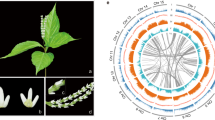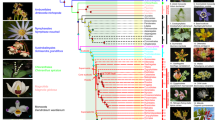Abstract
Here we discuss recent advances surrounding the origin of angiosperms. Putatively primitive characters are now much better understood because of a vastly improved understanding of angiosperm phylogenetics, and recent discoveries of fossil flowers have provided an increasingly detailed picture of early diversity in the angiosperms. The ‘anthophyte theory’, the dominant concept of the 1980s and 1990s, has been eclipsed; Gnetales, previously thought to be closest to the angiosperms, are related instead to other extant gymnosperms, probably most closely to conifers. Finally, new theories of flower origins have been proposed based on gene function, duplication and loss, as well as on morphology. Further studies of genetic mechanisms that control reproductive development in seed plants provide a most promising avenue for further research, including tests of these recent theories. Identification of fossils with morphologies that convincingly place them close to angiosperms could still revolutionize understanding of angiosperm origins.
This is a preview of subscription content, access via your institution
Access options
Subscribe to this journal
Receive 51 print issues and online access
$199.00 per year
only $3.90 per issue
Buy this article
- Purchase on Springer Link
- Instant access to full article PDF
Prices may be subject to local taxes which are calculated during checkout





Similar content being viewed by others
References
Frohlich, M. W. in Developmental Genetics of the Flower (eds Soltis, D. E., Leebens-Mack, J. H. & Soltis, P. S.) 63–127 (Academic, San Diego, CA, 2006)
Crane, P. R., Friis, E. M. & Pedersen, K. R. The origin and early diversification of angiosperms. Nature 374, 27–33 (1995)
Soltis, P. S., Endress, P. K., Chase, M. W. & Soltis, D. E. Angiosperm Phylogeny and Evolution (Sinauer, Sunderland, MA, 2005)
Saarela, J. M. et al. Hydatellaceae identified as a new branch near the base of the angiosperm phylogenetic tree. Nature 446, 312–315 (2007)
Rudall, P. J. et al. Morphology of Hydatellaceae, an anomalous aquatic family recently recognized as an early-divergent angiosperm lineage. Am. J. Bot. 94, 1073–1092 (2007)
Friis, E. M., Pedersen, K. R. & Crane, P. R. Cretaceous angiosperm flowers: Innovation and evolution in plant reproduction. Palaeogeogr. Palaeoclimatol. Palaeoecol. 232, 251–293 (2006)
Rydin, C., Pedersen, K. R., Crane, P. R. & Friis, E.-M. Former diversity of Ephedra (Gnetales): Evidence from Early Cretaceous seeds from Portugal and North America. Ann. Bot. (Lond.) 98, 123–140 (2006)
Friis, E. M., Doyle, J. A., Endress, P. K. & Leng, Q. Archaefructus—angiosperm precursor or specialized early angiosperm? Trends Plant Sci. 8, 369–373 (2003)
Ji, Q. et al. Early Cretaceous Archaefructus eoflora sp. nov. with bisexual flowers from Beipiao, Western Liaoning, China. Acta Geol. Sin. Engl. Edn 78, 883–896 (2004)
Anderson, J. M. & Anderson, H. M. Heyday of the Gymnosperms: Systematics and Biodiversity of the late Trassic Molteno Fructifications (National Botanical Institute, Pretoria, 2003)
Crane, P. R. Phylogenetic analysis of seed plants and the origin of angiosperms. Ann. Mo. Bot. Gard. 72, 716–793 (1985)
Doyle, J. A. & Donoghue, M. J. Seed plant phylogeny and the origin of angiosperms: an experimental cladistic approach. Bot. Rev. 52, 321–431 (1986)
Doyle, J. A. Seed plant phylogeny and the relationships of Gnetales. Int. J. Plant Sci. 157, S3–S39 (1996)
Burleigh, J. G. & Mathews, S. Assessing among-locus variation in the inference of seed plant phylogeny. Int. J. Plant Sci. 168, 111–124 (2007)
Hilton, J. & Bateman, R. M. Pteridosperms are the backbone of seed-plant phylogeny. J. Torrey Bot. Soc. 133, 119–168 (2006)
Bateman, R. M., Hilton, J. & Rudall, P. J. Morphological and molecular phylogenetic context of the angiosperms: contrasting the ‘top-down’ and ‘bottom-up’ approaches used to infer the likely characteristics of the first flowers. J. Exp. Bot. 13, 3471–3503 (2006)
Doyle, J. A. Seed ferns and the origin of angiosperms. J. Torrey Bot. Soc. 133, 169–209 (2006)
Doyle, J. A. & Endress, P. K. Morphological phylogenetic analysis of basal angiosperms: Comparison and combination with molecular data. Int. J. Plant Sci. 161, S121–S153 (2000)
Soltis, D. E. et al. The evolving floral genome: A history of genome-wide duplications and shifting patterns of gene expression. Trends Plant Sci. 12, 358–367 (2007)
Taylor, D. W. et al. Biogeochemical evidence for the presence of the angiosperm molecular fossil oleanane in Paleozoic and Mesozoic non-angiospermous fossils. Paleobiology 32, 179–190 (2006)
Auras, S. et al. Aromatized arborane/fernane hydrocarbons as biomarkers for Cordaites. Naturwissenschaften 93, 616–621 (2006)
Stebbins, G. L. Flowering Plants Evolution above the Species Level (Harvard Univ. Press, Cambridge, MA, 1974)
Retallack, G. & Dilcher, D. L. Arguments for a glossopterid ancestry of angiosperms. Paleobiology 71, 54–67 (1981)
Friedman, W. E. & Williams, J. H. Modularity of the angiosperm female gametophyte and its bearing on the early evolution of endosperm in flowering plants. Evolution Int. J. Org. Evolution 57, 216–230 (2003)
Hughes, N. F. 1994. The Enigma of Angiosperm Origins (Cambridge Univ. Press, Cambridge, 1994)
Krassilov, V. A. Angiosperm Origins: Morphological and Ecological Aspects (Pensoft Publishers, Sofia, Bulgaria, 1997)
Litt, A. Evaluation of A-function: evidence from the APETALA1 and APETALA2 gene lineages. Int. J. Plant Sci. 168, 73–91 (2007)
Albert, V. A., Gustafsson, M. H. G. & Di Laurenzio, L. in Molecular Systematics of Plants II: DNA Sequencing (eds Soltis, D. E., Soltis, P. S. & Doyle, J. J.) 349–374 (Kluwer Academic, Dordrecht, 1998)
Kramer, E. M., Jaramillo, M. A. & Di Stilio, V. S. Patterns of gene duplication and functional evolution during the diversification of the AGAMOUS subfamily of MADS box genes in angiosperms. Genetics 166, 1011–1023 (2004)
Zahn, L. M. et al. Conservation and divergence in the AGAMOUS subfamily of MADS-box genes: evidence of independent sub- and neofunctionalization events. Evol. Dev. 8, 30–45 (2006)
Skinner, D. J., Hill, T. A. & Gasser, C. S. Regulation of ovule development. Plant Cell 16, S32–S45 (2004)
Buzgo, M., Soltis, P. S. & Soltis, D. E. Floral developmental morphology of Amborella trichopoda (Amborellaceae). Int. J. Plant Sci. 165, 925–947 (2004)
Theissen, G. et al. in Developmental Genetics and Plant Evolution (eds Cronk, Q. C. B., Bateman, R. M. & Hawkins, J. A.) 173–206 (Taylor & Francis, London, 2002)
Theissen, G. & Becker, A. Gymnosperm orthologues of class B floral homeotic genes and their impact on understanding flower origin. Crit. Rev. Plant Sci. 23, 129–148 (2004)
Baum, D. A. & Hileman, L. C. in Flowering and its Manipulation (ed. Ainsworth, C.) 3–27 (Blackwell, Oxford, 2006)
Frohlich, M. W. & Parker, D. S. The Mostly Male theory of flower evolutionary origins: from genes to fossils. Syst. Bot. 25, 155–170 (2000)
Frohlich, M. W. in Developmental Genetics and Plant Evolution (eds Cronk, Q. C. B. & Bateman, R. M. & Hawkins, J. A.) 85–108 (Taylor & Francis, London, 2002)
Frohlich, M. W. An evolutionary scenario for the origin of flowers. Nature Rev. Genet. 4, 559–566 (2003)
Vázquez-Lobo, A. et al. Characterization of the expression patterns of LEAFY/FLORICAULA and NEEDLY orthologs in female and male cones of the conifer genera Picea, Podocarpus and Taxus: implications for current evo-devo hypotheses for gymnosperms. Evol. Dev. 9, 446–459 (2007)
Meyen, S. V. Origin of the angiosperm gynoecium by gametoheterotopy. Bot. J. Linn. Soc. 97, 171–178 (1988)
Kim, S. et al. Sequence and expression studies of A-, B-, and C-class Mads-box homologues in Eupomatia (Eupomatiaceae): support for the bracteate origin of the calyptra. Int. J. Plant Sci. 166, 185–198 (2005)
Jaramillo, M. A. & Kramer, E. M. The role of developmental genetics in understanding homology and morphological evolution in plants. Int. J. Plant Sci. 168, 61–72 (2007)
Long, J. & Barton, M. K. Initiation of axillary and floral meristems in Arabidopsis. Dev. Biol. 218, 341–353 (2000)
Causier, B. et al. Evolution in action: Following function in duplicated floral homeotic genes. Curr. Biol. 15, 1508–1512 (2005)
Margulies, M. et al. Genome sequencing in microfabricated high-density picolitre reactors. Nature 437, 376–380 (2005)
Burch-Smith, T. M., Anderson, J. C., Martin, G. B. & Dinesh-Kumar, S. P. Applications and advantages of virus-induced gene silencing for gene function studies in plants. Plant J. 39, 734–746 (2004)
David-Schwartz, R. & Sinha, N. Evolution and development in plants: bridging the gap. Int. J. Plant Sci. 168, 49–59 (2007)
De Bodt, S., Theissen, G. & Van de Peer, Y. Promoter analysis of MADS-box genes in eudicots through phylogenetic footprinting. Mol. Biol. Evol. 23, 1293–1303 (2006)
Boozer, C. et al. Looking towards label-free biomolecular interaction analysis in a high-throughput format: a review of new surface plasmon resonance technologies. Curr. Opin. Biotechnol. 17, 400–405 (2006)
Nalefski, E. A., Nebelitsky, E., Lloyd, J. A. & Gullans, S. R. Single-molecule detection of transcription factor binding to DNA in real time: Specificity, equilibrium, and kinetic parameters. Biochemistry 45, 13794–13806 (2006)
Pryer, K. M. et al. Horsetails and ferns are a monophyletic group and the closest living relatives to seed plants. Nature 409, 618–622 (2001)
Klavins, S. D., Taylor, T. N. & Taylor, E. L. Anatomy of Umkomasia (Corystospermales) from the Triassic of Antarctica. Am. J. Bot. 89, 664–676 (2002)
Moore, M. J. et al. Using plastid-genome-scale data to resolve enigmatic relationships among basal angiosperms. Proc. Natl. Acad. Sci. USA 104, 19363–19368 (2007)
Acknowledgements
M.W.F. thanks the National Science Foundation (USA) for supporting work in this area. We thank J. A. Doyle, E.-M. Friis, P. S. Soltis, R. M. Bateman, P. Kenrick, D. E. Soltis and J. Hilton for commenting on the manuscript, and J. Trager and Huntington Gardens for Welwitschia materials.
Author information
Authors and Affiliations
Corresponding author
Rights and permissions
About this article
Cite this article
Frohlich, M., Chase, M. After a dozen years of progress the origin of angiosperms is still a great mystery. Nature 450, 1184–1189 (2007). https://doi.org/10.1038/nature06393
Received:
Accepted:
Issue Date:
DOI: https://doi.org/10.1038/nature06393
This article is cited by
-
Reciprocal expression of MADS-box genes and DNA methylation reconfiguration initiate bisexual cones in spruce
Communications Biology (2024)
-
Mesozoic cupules and the origin of the angiosperm second integument
Nature (2021)
-
Transcriptome and morpho-physiological analyses reveal factors regulating cone bud differentiation in Qinghai spruce (Picea crassifolia Kom.)
Trees (2021)
-
A genome for gnetophytes and early evolution of seed plants
Nature Plants (2018)
-
The ancestral flower of angiosperms and its early diversification
Nature Communications (2017)
Comments
By submitting a comment you agree to abide by our Terms and Community Guidelines. If you find something abusive or that does not comply with our terms or guidelines please flag it as inappropriate.



